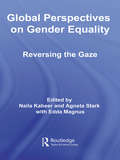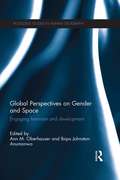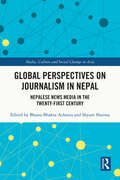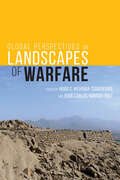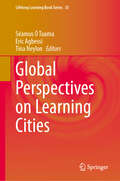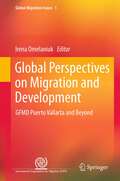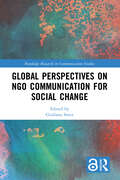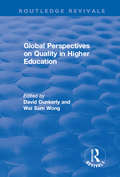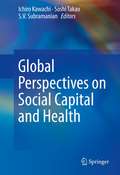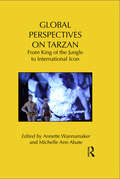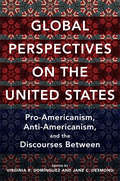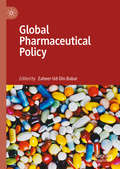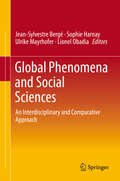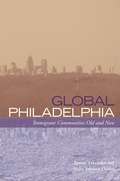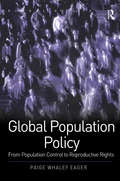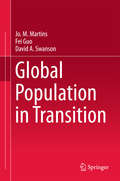- Table View
- List View
Global Perspectives on Gender Equality: Reversing the Gaze (Routledge/UNRISD Research in Gender and Development #Vol. 3)
by Naila Kabeer Agneta Stark Edda MagnusThe Nordic countries have long been seen as pioneers in promoting gender equality. The book brings together scholars from the global South and post-socialist economies to reflect on Nordic approaches to gender equality. The contributors to the book seek to explore from a comparative perspective the vision, values, policies, mechanisms, coalitions of interests and political processes that help to explain Nordic achievements on gender equality. While some contributors explore the Nordic experience through the prism of their own realities, others explore their own realities through the Nordic prism. By cutting across normal geographical boundaries, disciplinary boundaries and the boundaries between theory and policy, this book will be of interest to all readers with an interest in furthering gender equality.
Global Perspectives on Gender and Space: Engaging Feminism and Development (Routledge Studies in Human Geography)
by Ann M. Oberhauser and Ibipo Johnston-AnumonwoFeminism has re-shaped the way we think about equality, power relations and social change. Recent feminist scholarship has provided new theoretical frameworks, methodologies and empirical analyses of how gender and feminism are situated within the development process. Global Perspectives on Gender and Space: Engaging Feminism and Development draws upon this framework to explore the effects of globalization on development in diverse geographical contexts. It explores how women’s and men’s lives are gendered in specific spaces as well as across multiple landscapes. Traveling from South Asia to sub-Saharan Africa to North America and the Caribbean, the contributions illustrate the link between gender and global development, including economic livelihoods, policy measures and environmental change. Divided into three sections, Global Perspectives on Gender and Space showcases the following issues: One) the impact of neoliberal policies on transnational migration, public services and microfinance programs; Two) feminist and participatory methodologies employed in the evaluation of land use, women’s cooperatives and liberation struggles and Three) gendered approaches to climate change, natural disasters and conservation the global South. A feminist lens is the common thread throughout these sections that weaves gender into the very fabric of everyday life, providing a common link between varied spaces around the globe by mapping gendered patterns of power and social change. This timely volume provides geographic comparisons and case studies to give empirically informed insights on processes and practices relevant to feminism and development. It illustrates ways to empower individuals and communities through transnational struggles and grassroots organizations, while emphasizing human rights and gender equity, and will be of interest to those studying Geography, Development Studies, International Relations and Gender Studies.
Global Perspectives on Journalism in Nepal: Nepalese News Media in the Twenty–First Century (Media, Culture and Social Change in Asia)
by Bhanu Bhakta AcharyaWith more than 1000 newspapers, 1100 local radios, 200 television channels, 3000 online news portals, and over 80 colleges providing media education and training, news media, and media education are vibrant fields in Nepal. This book provides a comprehensive overview of Nepal’s news media, including empirical studies, critical reviews, and theoretical and philosophical analyses focusing on journalism and contemporary media practices in the country, using local standpoints and global perspectives. Laying foundations of academic research and discourse, it explores key issues about the state of media and journalism practices of Nepal and situates them against the professional standards of global journalism and journalism education. The book covers all news media, including traditional (newspaper, radio, and television) and digital platforms.
Global Perspectives on Landscapes of Warfare
by Hugo C. Ikehara-Tsukayama Juan Carlos Vargas RuizCopublished with Editorial de la Universidad del Magdalena Global Perspectives on Landscapes of Warfare examines the effects of conflict on landscapes and the ways landscapes have shaped social and political boundaries over time. Contributors from different archaeological traditions introduce a variety of methodologies and theories to understand and explain how territories and geographies in antiquity were modified in response to threat. Drawing from eleven case studies from periods ranging over eight thousand years in the Americas, Asia, and Europe, contributors consider how social groups moved and concentrated residences, built infrastructure, invested resources, created alliances and negotiated with human and nonhuman entities for aid, formed and reformed borders, and memorialized sites and territories. Because landscapes of warfare deal with built environments, chapters are presented with rich graphic documentation—detailed maps, site plans, and artifacts—to support the analysis and interpretations. Territories that have been appropriated and transformed by communities at war illustrate how built landscapes not only reflect immediate events but also influence subsequent generations. With a diverse array of case studies and an explicit focus on landscapes, Global Perspectives on Landscapes of Warfare will be of great interest to students and scholars of conflict archaeology and the anthropology and history of violence across the globe. Contributors: Elizabeth Arkush, Viktor A. Borzunov, Igor V. Chechushkov, Tiffany Earley-Spadoni, Nam C. Kim, Lauren Kohut, Takehiko Matsugi, Kerry Nichols, Russell S. Quick, Lizzie Scholtus, James T. Williams
Global Perspectives on Learning Cities (Lifelong Learning Book Series #35)
by Séamus Ó Tuama Eric Agbessi Tina NeylonThis book examines the social, political and economic rationales, which lead to the development of learning cities in diverse settings in Africa, Australia, Asia and Europe. Many of the contributors are practitioners who have played an active part in the development of their learning city. Some contributors are both practitioners and researchers on learning cities. Some are primarily researchers who are focused on understanding learning cities, gauging the benefits and potential of learning cities and formulating new theories and approaches. The book also includes interviews with and contributions from key founding figures in the learning cities movement and in the development of UNESCO&’s Global Network of Learning Cities. The book explores diverse initiatives that are shaping the lives of people in cities today and into the future, fostering inclusivity, sustainability, and resilience. Each chapter offers a unique perspective on the transformative power of lifelong learning and collective commitment. Contributors share their insights, from grassroots to high level policy discussions, shedding light on the challenges and triumphs encountered along the way. This is the first major book looking at learning cities across the globe from both theoretical and practical perspectives. What sets it apart is the diversity in the material offered and the geographical and cultural spread of contexts. Cities are becoming ever more important to the future of humanity, learning cities are a vast laboratory of new and innovative ways in which people can learn together to create more fulfilling lives, better opportunities and put into practice on a daily basis the four principles outlined in the Delors Report (1996): Learning to know, Learning to do, Learning to live together, Learning to be. This book is a valuable resource for policymakers, educators, and community leaders striving to build more inclusive and sustainable societies. Whether embarking on the journey of developing a learning city or seeking inspiration from successful initiatives, readers will find practical insights and thought-provoking perspectives within these pages.
Global Perspectives on Long Term Community Resource Management (Studies in Human Ecology and Adaptation #11)
by Ludomir R. Lozny Thomas H. McGovernCommunal-level resource management successes and failures comprise complex interactions that involve local, regional, and (increasingly) global scale political, economic, and environmental changes, shown to have recurring patterns and trajectories. The human past provides examples of long-term millennial and century-scale successes followed by undesired transitions (“collapse”), and rapid failure of collaborative management cooperation on the decadal scale. Management of scarce resources and common properties presents a critical challenge for planners attempting to avoid the "tragedy of the commons" in this century. Here, anthropologists, human ecologists, archaeologists, and environmental scientists discuss strategies for social well-being in the context of diminishing resources and increasing competition.The contributors in this volume revisit “tragedy of the commons” (also referred to as “drama” or “comedy” of the commons) and examine new data and theories to mitigate pressures and devise models for sustainable communal welfare and development. They present twelve archaeological, historic, and ethnographic cases of user-managed resources to demonstrate that very basic community-level participatory governance can be a successful strategy to manage short-term risk and benefits. The book connects past-present-future by presenting geographically and chronologically spaced out examples of communal-level governance strategies, and overviews of the current cutting-edge research. The lesson we learn from studying past responses to various ecological stresses is that we must not wait for a disaster to happen to react, but must react to mitigate conditions for emerging disasters.
Global Perspectives on Migration and Development: GFMD Puerto Vallarta and Beyond
by Irena OmelaniukThis volume is the first in a new Springer series to examine one of humanity's most pressing concerns: global migration and its implications for development. As population mobility grows in an ever more crowded world, the Global Forum on Migration and Development (GFMD) has emerged as the most important global mechanism to deal with the urgent challenges it presents. This book explores fresh strategies proposed by the GFMD in its fourth year of operation in Mexico and beyond. Interrogating the relationship between migration and development, the papers advance the Global Forum's aims of reducing poverty and empowering low-income families everywhere. In 2010, there were 214 million international migrants worldwide, nearly two and a half times the number in 1965. By 2050, international migration is likely to expand sharply in scale, reach and complexity, due to growing demographic disparities, environmental change, shifting global political and economic dynamics, technological innovations and social networks. Migration can bring substantial gains to families in less-developed countries, and mobile labor is an axiomatic feature of the global economy. Yet outward migration of skilled workers can seriously retard development at home, and exert pressure on wages in host nations. Balancing these and other conflicting concerns requires the substantive and expert discourse offered in this book. Contributors discuss, and propose concrete solutions to, vital issues such as the debilitating costs of cross-border labor recruitment and the provision of social and income protection for foreign contract workers. With suggestions on how to facilitate connections between transnational families, and gender- and family-sensitive immigration regimes, this book aims to foster collaborative intergovernmental links as well as partnerships between governments, civil society and international organizations. It shows how the GFMD can positively influence policy and institutional behavior while addressing wider systemic factors in protecting mobile workers.
Global Perspectives on Motherhood, Mothering and Masculinities
by Tólá Olú Pearce;Andréa MoraesThe two phenomena highlighted in this edited volume 'motherhood/mothering and masculinities' are each recent areas of development in critical Feminist and Men's Studies. In contributing to these areas of gender studies, this book draws attention to the fact that much can also be gained when we explore relationships between them, an idea that may not readily come to mind. While femininities and masculinities are co-constructed, motherhood and mothering bring additional perspectives to the study of femininity that affect the construction of masculinity in complex ways. The 12 chapters in this volume allow readers to ponder some of these complexities and may suggest other issues that require investigation. Spanning many continents, the essays have both a global and historical reach emphasising cultural differences and historical changes. Of import is the idea that mothers have agency and are active in constructions affecting their lives. They are able to bring motherhood out of the shadows as they strive to build, re-evaluate, or alter their roles within families and communities. These have an impact on developments in masculinities. The book is divided into three parts and the chapters investigate a wide range of issues including cultural constructs, gender in parent/child, relationships, non-binary developments, the impact of war on mothering, decolonisation struggles, and much more.
Global Perspectives on NGO Communication for Social Change (Routledge Research in Communication Studies)
by Giuliana SorceThis book examines the central role media and communication play in the activities of Non-Governmental Organizations (NGOs) around the globe, how NGOs communicate with key publics, engage stakeholders, target political actors, enable input from civil society, and create participatory opportunities. An international line-up of authors first discuss communication practices, strategies, and media uses by NGOs, providing insights into the specifics of NGO programs for social change goals and reveal particular sets of tactics NGOs commonly employ. The book then presents a set of case studies of NGO organizing from all over the world—ranging from Sudan via Brazil to China – to illustrate the particular contexts that make NGO advocacy necessary, while also highlighting successful initiatives to illuminate the important spaces NGOs occupy in civil society. This comprehensive and wide-ranging exploration of global NGO communication will be of great interest to scholars across communication studies, media studies, public relations, organizational studies, political science, and development studies, while offering accessible pieces for practitioners and organizers.
Global Perspectives on Quality in Higher Education (Routledge Revivals)
by DAVID DUNKERLEY AND WAI SUM WONGThis title was first published in 2001: An edited collection of essays from experts in the field of quality assurance in higher education. Each contributor provides a summary of recent developments in the respective countries centred on specific themes. They include an outline of the nature of higher education in the various countries, a description of recent developments in higher education quality assurance mechanisms together with discussions of the role of government, funding, the implications of emerging new trends such as distance learning, and non-traditional modes of delivery and assessment. The book should be of use to those working in higher education - both academics and policy makers - because of its comparative focus and ability to compare strategies and structures from one country to another. Similarly those working directly in assuring quality issues should also find the volume valuable.
Global Perspectives on Rural Childhood and Youth: Young Rural Lives (Routledge Studies in Human Geography)
by Ruth Panelli Elsbeth Robson Samantha PunchThis collection of international research and collaborative theoretical innovation examines the socio-cultural contexts and negotiations that young people face when growing up in rural settings across the world. This book is strikingly different to a standard edited book of loosely linked, but basically independent, chapters. In this case, the book presents both thematically organised case studies and co-authored commentaries that integrate and advance current understandings and debates about rural childhood and youth.
Global Perspectives on Same-Sex Marriage: A Neo-Institutional Approach (Global Queer Politics)
by Maxime Forest Bronwyn Winter Réjane SénacThis book provides a comparative, neo-institutionalist approach to the different factors impacting state adoption of—or refusal to adopt—same-sex marriage laws. The now twenty-one countries where lesbians and gay men can legally marry include recent or longstanding democracies, republics and parliamentary monarchies, and unitary and federal states. They all reflect different positions with respect to religion and the cultural foundations of the nation. Countries opposed to such legalization, and those having taken measures in recent years to legally reinforce the heterosexual fundaments of marriage, present a similar diversity. This diversity, in a globalized context where the idea of same-sex marriage has become integral to claims for LGBTI equality and indeed LGBTI human rights, gives rise to the following question: which factors contribute to institutionalizing same-sex marriage? The analytical framework used for exploring these factors in this book is neo-institutionalism. Through three neo-institutionalist lenses—historical, sociological and discursive—contributors investigate two aspects of the processes of adoption or opposition of equal recognition of same-sex partnerships. Firstly, they reveal how claims by LGBTIQ movements are being framed politically and brought to parliamentary politics. Secondly, they explore the ways in which same-sex marriage becomes institutionalized (or resisted) through legal and societal norms and practices. Although it adopts neo-institutionalism as its main theoretical framework, the book incorporates a broad range of perspectives, including scholarship on social movements, LGBTI rights, heterosexuality and social norms, and gender and politics.
Global Perspectives on Social Capital and Health
by Ichiro Kawachi S. V. Subramanian Soshi TakaoThis book is a follow up to Social Capital and Health (2008), edited by Kawachi, Subramanian & Kim. Global Perspectives on Social Capital and Health provides a timely update on emerging topics in a fast-growing field, and features contributions from an outstanding international team of scholars, selected from a diverse range of disciplinary backgrounds including: social epidemiology, medical geography, social psychology, social welfare and gerontology, pediatrics, political science, economics, and medical sociology. The book is organized in three parts: Part 1. Emerging directions in social capital research. This section highlights novel directions in social capital research. These include: a) novel settings for conducting research on social capital (workplaces, schools), b) new approaches for causal inference in social capital (instrumental variable analysis, twin fixed effects designs); c) cutting-edge directions for social capital research, including studies of the origins of community social capital, the use of social network analysis to investigate social capital, and novel methods for investigating the link between social capital and crime. Part 2. Social capital and health policy. The three chapters in this section highlight implications of social capital for interventions and health policy. Part 3. Social capital and health in global perspective The four chapters in this section look at research on social capital and health from a global perspective. The authors summarize the empirical studies on social capital and health conducted in each country/region, or each population group; discuss how the concept of social capital "translates" across different cultures; and identify challenges and future directions for research.
Global Perspectives on Tarzan: From King of the Jungle to International Icon (Routledge Research in Cultural and Media Studies)
by Michelle Ann Abate Annette WannamakerThis collection seeks to understand the long-lasting and global appeal of Tarzan: Why is a story about a feral boy, who is raised by apes in the African jungle, so compelling and so adaptable to different cultural contexts and audiences? How is it that the same narrative serves as the basis for both children’s cartoons and lavish musical productions or as a vehicle for both nationalistic discourse and for light romantic fantasy? Considering a history of criticism that highlights the imperialistic, sexist, racist underpinnings of the original Tarzan narrative, why would this character and story appeal to so many readers and viewers around the world? The essays in this volume, written by scholars living and working in Australia, Canada, Israel, The Netherlands, Germany, France and the United States explore these questions using various critical lenses. Chapters include discussions of Tarzan novels, comics, television shows, toys, films, and performances produced or distributed in the U.S., Canada, Israel, Palestine, Britain, India, The Netherlands, Germany and France and consider such topics as imperialism, national identities, language acquisition, adaptation, gender constructions, Tarzan’s influence on child readers and Tarzan’s continued and broad influence on cultures around the world. What emerges, when these pieces are placed into dialogue with one another, is an immensely complex picture of an enduring, multi-faceted global pop culture icon.
Global Perspectives on War, Gender and Health: The Sociology and Anthropology of Suffering (Global Connections Ser.)
by Hannah BradbyRendering the suffering of the marginalized visible has been an important aspect of feminist sociological studies of health, illness and medicine, with the subjective experience of those without access to institutional power being at the forefront of the research. This volume analyzes the links between the suffering caused by the intentional violence of war and the unintentional suffering engendered by modern medicinal processes. By establishing a fitting tribute to the academic and campaigning work of Meg Stacey, Global Perspectives on War, Gender and Health responds to her challenge of ’why medical sociology had not yet turned its gaze upon the health consequences of war’. A selection of international case studies are used to create a volume of significant interest to sociologists and those working in the fields of anthropology, social policy, social work, peace, war and security studies, and international development.
Global Perspectives on Well-Being in Immigrant Families
by Radosveta Dimitrova Michael Bender Fons van de VijverGlobal Perspectives on Well-Being in Immigrant Families addresses how immigrant families and their children cope with the demands of a new country in relation to psychological well-being, adjustment, and cultural maintenance. The book identifies cultural and contextual factors that contribute to well-being during a family's migratory transition to ensure successful outcomes for children and youth. In addition, the findings presented in this book outline issues for future policy and practice including preventive practices that might allow for early intervention and increased cultural sensitivity among practitioners, school staff, and researchers.
Global Perspectives on Women’s Leadership and Gender (In)Equality
by Elena V. Shabliy Dmitry Kurochkin Gloria Y. A. AyeeThis interdisciplinary volume discusses women’s global leadership and women’s rights advancement, identifying gender inequality as a persisting societal challenge and a major barrier to human development. Drawing on intersectionality as an important analytic and methodological tool, the contributors analyse women’s leadership roles across the world, featuring perspectives on the US, Israel, and Brazil, amongst other countries. The book also contributes to the growing field of leadership, presenting cross-cultural examples and case-studies of outstanding women and female leaders, as well as discussing contemporary leadership theories, and examining obstacles to women’s leadership. Global Perspectives on Women’s Leadership and Gender (In)Equality will be an important point of reference for students and scholars across the political sciences, women’s studies, feminist philosophy, business development, and history.
Global Perspectives on the United States: Pro-Americanism, Anti-Americanism, and the Discourses Between
by Jane Desmond Virginia DominguezThis daring collaborative effort showcases dialogues between international scholars engaged with the United States from abroad. The writers investigate the analytic methods and choices that label certain talk, images, behaviors, and allusions as "American" and how to read the data on such material. The editors present the essays in pairs that overlap in theme or region. Each author subsequently comments on the other's work. A third scholar or team of scholars from a different discipline or geographic location then provides another level of analysis. Contributors: Andrzej Antoszek, Sophia Balakian, Zsófia Bán, Sabine Bröck, Ian Condry, Kate Delaney, Jane C. Desmond, Virginia R. Dominguez, Ira Dworkin, Richard Ellis, Guillermo Ibarra, Seyed Mohammad Marandi, Giorgio Mariani, Ana Mauad, Loes Nas, Edward Schatz, Manar Shorbagy, Kristin Solli, Amy Spellacy, and Michael Titlestad.
Global Pharmaceutical Policy
by Zaheer-Ud-Din BabarMedicines are vital in improving patient health outcomes and pharmaceutical policy is a fundamental component of any health system. However, the global pharmaceutical policy is ever-evolving and data and quality ‘research-based information’ in this field are scarce. This book fills this gap and provides up-to-date empirical information and evidence-based synthesis. It focuses on pertinent key issues in global pharmaceutical policy including medicines safety, generic medicines, pharmaceutical supply chain, medicines financing, access and affordability of medicines, rational use of medicines, pharmacy health services research and access to vaccines and biological products. Featuring policy case studies from varied countries such as Mexico, Russia, China, Kyrgyzstan, and Pakistan, this book comprises a valuable and comprehensive resource for students, funders, policymakers, academics, and researchers interested in this field.
Global Phenomena and Social Sciences
by Jean-Sylvestre Bergé Sophie Harnay Ulrike Mayrhofer Lionel ObadiaThis book offers new perspectives on global phenomena that play a major role in today's society and deeply shape the actions of individuals, organizations and nations. In a complex and rapidly changing environment, decision-makers need to gain a better understanding of global phenomena to adapt and to anticipate the evolution of the global context. The authors--ten renowned international scholars of anthropology, economics, law, management and political science--propose an interdisciplinary and comparative approach to social sciences. They analyse how international phenomena, such as globalisation or transnationalisation, transform the disciplines of social sciences from an epistemological standpoint. Explaining what 'global' means in difference disciplines, the authors analyse several global phenomena that characterise today's international environment such as the circulation of norms and ideas, the linkages between war and globalization, corporate governance, and the impact of multinational enterprises on sustainable development and poverty reduction. Providing examples of analytical disciplinary approaches and guidelines for decision-makers in a fast-changing global context this book will be useful to scholars and students of anthropology, economics, law, management and political science as well as practitioners in the private and public sectors.
Global Philadelphia: Immigrant Communities Old and New
by Mary Johnson Takenaka Ayumi OsirimThe racial and ethnic composition of Philadelphia continues to diversify as a new wave of immigrants—largely from Asia and Latin America—reshape the city’s demographic landscape. Moreover, in a globalized economy, immigration is the key to a city’s survival and competitiveness. The contributors to Global Philadelphiaexamine how Philadelphia has affected its immigrants’ lives, and how these immigrants, in turn, have shaped Philadelphia. Providing a detailed historical, ethnographic, and sociological look at Philadelphia’s immigrant communities, this volume examines the social and economic dynamics of various ethnic populations. Significantly, the contributors make comparisons to and connections between the traditional immigrant groups—Germans, Italians, the Irish, Jews, Puerto Ricans, and Chinese—and newer arrivals, such as Cambodians, Haitians, Indians, Mexicans, and African immigrants of various nationalities. While their experiences vary, Global Philadelphia focuses on some of the critical features that face all immigrant groups—intra-group diversity, the role of institutions, and ties to the homeland. Taken together, these essays provide a richer understanding of the processes and implications of contemporary immigration to the area.
Global Pop: World Music, World Markets
by Timothy D TaylorGlobal Pop examines the rise of "world musics" and "world beat", and some of the musicians associated with these recent genres such as Peter Gabriel, Ladysmith Black Mambazo, and Johnny Clegg. Drawing on a wide range of sources - academic, popular, cyber, interviews, and the music itself - Global Pop charts an accessible path through many of the issues and contradictions surrounding the contemporary movement of people and musics worldwide. Global Pop examines the range of discourses employed in and around world music, demonstrating how the central concept of authenticity is wielded by musicians, fans, and other listeners, and looks at some of these musics in detail, examining ways they are caught up in forms of domination and resistance. The book also explores how some cross-cultural collaborations may fashion new musics and identities through innovative combinations of sounds and styles.
Global Population Policy: From Population Control to Reproductive Rights (Global Health)
by Paige Whaley EagerThe general assumption throughout history has been that a growing population is beneficial for societies. By the mid-1960s, however, the United States and other developed countries became convinced that population control was an absolute necessity, especially in the developing world. This absorbing study explains why population control is no longer the focus of global population policy and why reproductive rights and health have become the major focus. The book highlights the role that the US and other developed countries play in affecting global population policy, looking in particular at the stance of the George W. Bush administration since taking office. It also studies the influence of the UN as an international forum and explores how civil society questioned the ethics of population control. Global Population Policy will appeal to a wide audience, including readers in the fields of women's studies, development politics and international relations.
Global Population in Transition
by David A. Swanson Jo. M. Martins Fei GuoThis book deals with macro and micro aspects of population change and their inter-face with socio-economic factors and impact. It examines theoretical notions and pursues their empirical manifestations and uses multidisciplinary approaches to population change and diversity. It investigates the organic nature of the relationships between socio-economic factors and population change and the feedback loops that affect socio-economic organisation and behaviour. The book brings together material often scattered in a number of sources and disciplines that helps to understand population change and their socio-economic aspects. In addition to dealing with the more conventional factors in population dynamics in the form of fertility, mortality and migration, the book examines socio-economic forces that influence them. It discusses population evolving attributes that affect population characteristics and social and behaviour and impact on the environment. Further, it deals with social organisation and pathways that lead to different social and economic development and standards of living of diverse populations.
Global Population: History, Geopolitics, and Life on Earth
by Alison BashfordConcern about the size of the world's population did not begin with the "population bomb" in 1968. It arose in the aftermath of World War I and was understood as an issue with far-reaching ecological, agricultural, economic, and geopolitical consequences. The world population problem concerned the fertility of soil as much as the fertility of women, always involving both "earth" and "life." Global Population traces the idea of a world population problem as it evolved from the 1920s through the 1960s. The growth and distribution of the human population over the planet's surface came deeply to shape the characterization of "civilizations" with different standards of living. It forged the very ideas of development, demographically defined three worlds, and, for some, an aspirational "one world." Drawing on international conference transcripts and personal and organizational archives, this book reconstructs the twentieth-century population problem in terms of migration, colonial expansion, globalization, and world food plans. Population was a problem in which international relations and intimate relations were one. Global Population ultimately shows how a geopolitical problem about sovereignty over land morphed into a biopolitical solution, entailing sovereignty over one's person.
